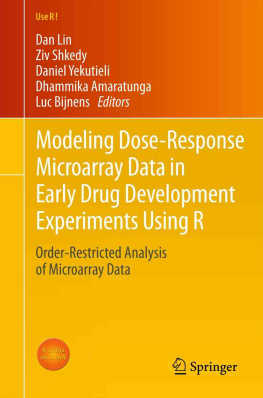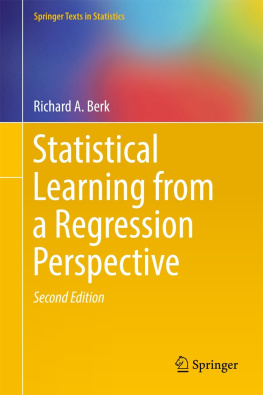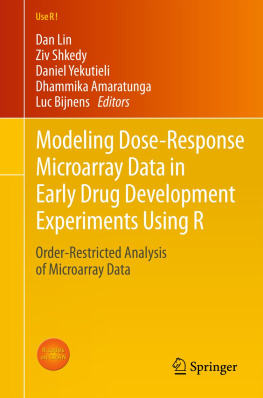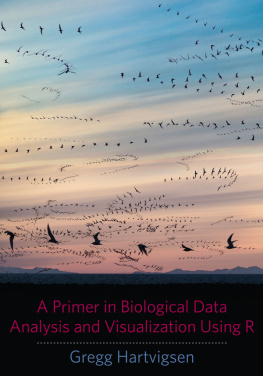Dan Lin , Ziv Shkedy , Daniel Yekutieli , Dhammika Amaratunga and Luc Bijnens (eds.) Use R! Modeling Dose-Response Microarray Data in Early Drug Development Experiments Using R 2012 Order-Restricted Analysis of Microarray Data 10.1007/978-3-642-24007-2_1 Springer-Verlag Berlin Heidelberg 2012
1. Introduction
Abstract
The development of new and innovative treatments for unmet medical (Barlow et al. 1972) needs is the major challenge in biomedical research. Unfortunately, for the past decade, there has been a steady decline in the number of new therapies reaching the market, despite of the increased investments in pharmaceutical R&D (FDA 2004). One of the most critical steps in a drug discovery program is target identification and validation (Sams-Dodd 2005).
1.1 Introduction
The development of new and innovative treatments for unmet medical (Barlow et al. ). Confirmation that a compound inhibits the intended target (drug target validation) and the identification of undesirable secondary effects are among the main challenges in developing new drugs. This is the reason why dose-response experiments are pivotal in drug discovery programs. Dose-response experiments help us to understand how the drug works and to explore whether it has the desired properties of a potential novel therapy. A compound will only move further in clinical testing when it has a side effect profile that is acceptable within the dose range that demonstrates a high level of target activity.
Dose-response experiments have a simple concept. The compound of interest is administered at several doses to a biological sample (a cell line, an animal model, a human volunteer, or a patient) and the response is measured. Dose-response experiments allow researchers to assess the relationship between the dose (amount, concentration) of a drug and the response observed. Despite the conceptual simplicity, however, the practical analysis is much more complicated. First, a response can change dose-dependently in a lot of different ways, and many of dose-response relationship are complex and nonlinear. Second, it is difficult to choose an appropriate response measure. Often one may want to investigate even more than one response. This is because a treatment will generally lead to multiple biological reactions, and one needs to try to disentangle direct from indirect responses and desired from undesired effects.
1.2 Dose-Response Modeling
Dose-response models aim to describe the dependency of a specific response on dose. Dose quantifies the amount of drug the subject is exposed to. Most commonly it measures the weight of the chemical compound and is expressed in absolute terms such as milligram (mg) or grams (g) when dealing with clinical studies or in relative terms such as mg/kg when dealing with in vivo animal experiments. The dose as such, however, is not the direct cause for the response or response profile. In fact, in most cases, the molecular concentration at the site of action drives the response to a drug. This information is seldom readily available or even measurable. A precursor for this information is the drug concentration in the blood. Therefore, whenever drug concentrations in plasma are available, dose can be easily, and arguably should be, replaced by concentration. Since this information is not always at hand, dose is a good alternative. There are methods which under certain circumstances, e.g., knowledge of the pharmacokinetic profile of the compound under study, can be used to work with concentration instead of dose when no plasma samples are available (Jacqmin et al. ). A detailed description of these techniques is beyond the scope of this book.
Response can basically be any observation of interest that can be measured. Examples range from continuous data, e.g., body weight data, to binomial data where the presence of an event is observed (yes or no) or multinomial data where multiple levels are possible such as different pain scores or types of adverse events. Although the goal of dose-response modeling for each possible type of response is the same, finding an optimal dose, the methodology behind it will differ greatly from one type to the other. The main focus of the book is on continuous data and in particular the evolution of the mean gene expression with respect to dose.
Ruberg ().
Dose-response modeling refers to implementing a mathematical representation of some true and unknown relationship. Dose-response models can be classified as being empirical or mechanistic in nature. An empirical model, such as the four-parameter logistic model, discussed in , serves to adequately describe the observed pattern between a dose and a response without giving an understanding of the underlying biological process. In other words, the parameters present in the model do not represent biological processes. A mechanistic model on the other hand uses mechanistical pathways to explain the observed pattern. In this book, we focus on the first type of models.
1.3 Dose-Response Microarray Experiments
Now the genome of man and other species have been completely sequenced, we enter the so-called post-genomic era that concentrates on harvesting the fruits hidden in the genomic text (Lengauer ). The major issue with microarray data analysis is the curse of high dimensionality. Because so much information is gathered on biological activity, it becomes a challenge to find the relevant information in the haystack of irrelevant information. One runs the risk of missing the interesting results in a mass of false positive findings.
Microarray dose-response experiments allow researchers to study the relationship between the dose of a drug and the activity of an entire genome at once. It combines the information wealth of microarrays with the benefits of dose-response studies. Their combined use yields two additional advantages. First, the proportion of false positive findings will be substantially reduced as more information on the entire dose-response profile is collected. False positive genes identified by a one-dose treatment study are easier to unmask in multiple-dose studies when the gene has an unrealistic dose-response relationship. Second, genes within the same biological sample may respond differently to drug dose. One therefore wants to investigate more than one gene. How many exactly is difficult to say, but in a discovery phase, it is typically the more the better. In early stages of drug development, one indeed tries to explore as many potential effects of the drug as possible. A microarray dose-response experiment studies the entire genome at once, and is therefore an ideal tool to elucidate variation in dose-dependency of a treatment across all genes and all known pathways.
Although analysis of gene expression data is the main focus of the book, the discussion about microarray technology is beyond the scope of this book. We refer to Amaratunga and Cabrera () for an elaborate discussion about the microarray technology and topics related to the analysis of microarray data.









